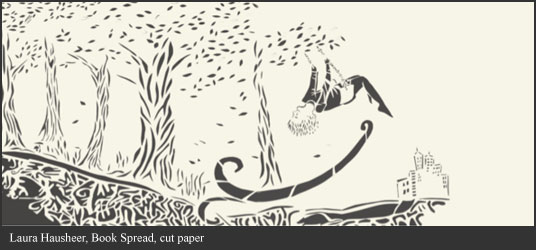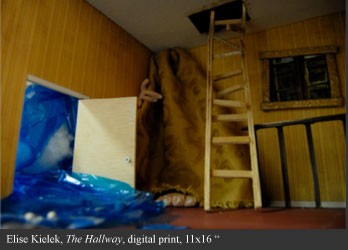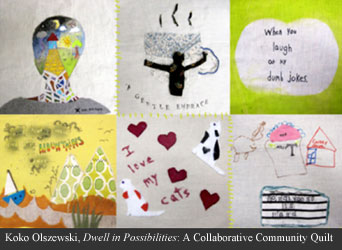St. Mary's Project in Studio Art / In-Progress Exhibition, Fall 2011
Boyden Gallery, December 5-9 Opening Reception, Monday, Dec. 5, 4:45 pm
Remina Greenfield / Laura Hausheer / Elise Kielek / Koko Olszewski / Samantha Nickey / Jennifer Metz
(click names or scroll down for artist statements)
The goal of my artwork is not to inspire a fear of technology, but to initiate a more thoughtful consideration of the ways it affects us. What can our inventions tell us as reflections of ourselves? My artworks compare the two encoded information systems that have the greatest effect on us: DNA and computer code. To create my images, I do not use any visual editing software – I open images as text files and directly alter the code. Though I am not well versed in computer programming, I have studied the code through experimentation and can create my own compositions. The images are not the result of unexpected changes. Each one is intentional. This process mirrors the way we analyze and experiment, attempting to understand and control all aspects of life. download a PDF of Remina Greenfield's Document Book (complete semester writings and research)
In paper cutting, pieces of paper are subtracted and added as a way to physically transform the identity of the material. This same theme of identity formation occurs within the narrative of my book. A little girl named Charli goes on an adventure in an unfamiliar city that ultimately ends in a revelation of self-discovery. Identity is formed much like paper cuts through a process of transformation. However instead of physical manipulation, we are the product of our experiences. Where we come from, the people we know, and all of our life circumstances form us into unique individuals. As Charli’s identity solidifies over time she finds herself wearing various “hats” which serve as symbols of identity within the story. As an artist I found myself trying on various “hats” as I went through a process of self-discovery, developing the narrative and illustrations of my book while coming to terms with my style of storytelling. I learn more about Charli, paper cutting, and myself all the time and I am not yet finished with my own adventure. One of the most important lessons I have learned from my work thus far is that an identity cannot simply be dreamed up overnight; instead, it must be cut and shaped over time. The self is not a discovery, but a creation. download a PDF of Laura Hausheer's Document Book (complete semester writings and research)
Elise Kielek
Throughout this semester, I have been creating and then photographing models of spaces from my own imagination that evoke feelings of mystery and the ethereal and haunting qualities of dream worlds. Through photography, a medium that suggests reality and documentation, I attempt to capture the moments through which the world of reality and the world of the fantastic dream cross over, enveloping the viewer in a state of altered belief. I challenge them to question whether the image I provide is a real and existing space, or whether they must dispel it as a fantasy, or a fairy tale. I urge them to, just for a moment, believe in the impossible reality of these spaces. I tend to draw from iconic images within children’s stories and fairy tales: an enchanted bedroom forest, a troll behind the curtain, a monster under the stairs, a castle in the sky. With these images, I gesture toward the imagination that we once had as children when we believed that anything was possible. download a PDF of Elise Kielek's Document Book (complete semester writings and research)
Koko Olszewski
Samantha Nickey
Scientists theorize that the moth is attracted to light either because it is searching for the darkest point behind the light or because it naturally navigates by the moon’s light. For this reason, I consider the moth akin to a person searching for a place of refuge prone to being distracted or misguided on their journey. The moth’s tragic death is therefore either a result of innocence or a result of ignorance but either way it is self-destructive and represents our detrimental urges. download a PDF of Samantha Nickey's Document Book (complete semester writings and research)
Jennifer Metz
My current body of work consists of photographic collages that manipulate the subject by deconstructing it, calling attention to two types of vision: the way the camera lens sees and the way the human eye sees. By dismantling what we would normally consider a “whole” image into small parts and removing parts from that whole, the fixed nature of the image is deconstructed. People have grown too accustomed to photographic seeing, passively accepting photographs as an accurate depiction of the world. Multiple snapshots placed on top of one another repeatedly impose the rectangular frame, breaking apart single elements in the landscape. The subtle distortion created by the lens that is usually unnoticeable in a single large image is magnified because of its frequent occurrence in a single landscape. By dismantling and layering the images, I force my audience to actively reconstitute wholes from multiple parts, thus making them reexamine the familiar. My ultimate goal with this work is to encourage the audience to actively engage with and examine their environments rather than remain passive viewers who merely accept the world around them. My work is about seeing more vividly: finding the unique in the familiar. download a PDF of Jennifer Metz's Document Book (complete semester writings and research)
Close Window (and Return to SMCM Art and Art History Web Pages)
|





